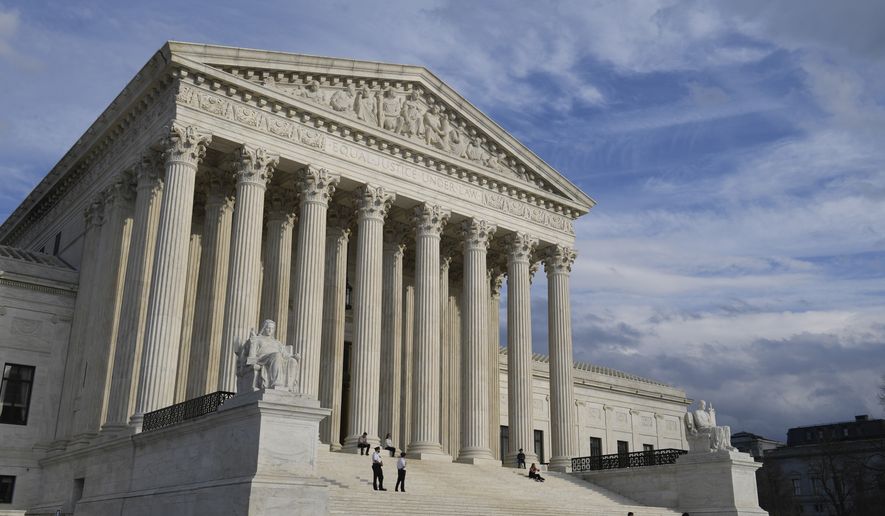The Supreme Court delivered fewer ideologically divided rulings in its most recent term than in last year’s as the conservative majority found middle ground with the court’s liberal wing on several issues.
Several of the much-watched legal disputes yielded more agreement among the justices even though the number of cases this term was similar to last year’s.
Adam Feldman, a Supreme Court scholar and creator of the Empirical SCOTUS blog, noted that the justices issued five ideologically divided decisions in the 2022 term, compared with 14 in the 2021 session.
“Last term kind of proved a lot of people’s thinking correct — that having a 6-3 court can really push ideology,” he said. “This term, we saw a lot less of that.”
Curt Levey, president of the Committee for Justice, said half of the major cases this term yielded liberal outcomes. He noted that the justices sided with the Biden administration’s argument that states couldn’t challenge federal deportation policies.
“All of this tells us that the current Supreme Court is more centrist than it is right-wing, despite the left screaming otherwise,” Mr. Levey said.
Mr. Feldman said the justices shifted to the center after criticism of the court and declining public approval of the landmark rulings last summer on abortion and gun rights.
In 2022, the high court overturned the national right to abortion and sent the issue back to the states. Liberals were outraged after a draft opinion was leaked, sparking protests and even an assassination attempt on Justice Brett M. Kavanaugh.
The justices also struck down strict gun control laws that required a subjective reason — proving a proper need — for obtaining a concealed carry permit in New York. The ruling also prohibited strict gun measures in a handful of other states, angering liberals further.
A Marquette Law School poll conducted after those June 2022 rulings showed that public approval of the justices had fallen to 38% from 54% just four months earlier.
Mr. Feldman surmised that the liberal justices might be motivated to find a middle ground because the conservatives have the numbers to push agendas.
The narrowing of the court’s ideological divide was evident in three highly watched cases this term involving voting rights, religious liberty and the independent legislature theory.
The justices’ rejections of two arguments from Republican lawmakers preserved part of the Voting Rights Act and ensured a right to challenge election laws in state courts.
In a case involving Alabama’s congressional map, the Republicans urged the high court to reject arguments from Black voters for a second majority Black district. They said such a move would force the government to take race into account.
In a 5-4 ruling, the justices ordered Alabama to adopt a congressional map that includes two majority Black districts. They reasoned that the current map violates the Voting Rights Act because it unfairly dilutes the power of the state’s Black residents.
Justice Kavanaugh joined Chief Justice John G. Roberts Jr. and the three liberal justices in the majority in that decision.
Liberals feared the conservative majority would roll back part of the Voting Rights Act and rule in another case that election laws could be challenged only in federal courts.
Many state officials and judges changed election laws without legislative approval during the depths of the COVID-19 pandemic.
In Moore v. Harper, North Carolina Republicans disputed the state’s highest court ruling that their congressional map was a partisan gerrymander. They argued that only federal courts, not the state’s highest court, had jurisdiction over their election laws.
The justices rejected that premise.
The 6-3 decision was not ideologically divided. Chief Justice Roberts and Justices Kavanaugh and Amy Coney Barrett joined the three liberals in shooting down Republican lawmakers’ theory that the U.S. Constitution invested final say over election rules with “the legislature” of each state and that state courts must butt out.
They said elections are conducted under federal and state constitutions, so state courts have a say.
A religious liberty dispute involving a former postal worker requesting not to work on the Sabbath also drew a compromise between the left and right wings of the court.
Resistant businesses must show they would incur a “substantial” cost if they accommodate religiously observant employees’ needs, the Supreme Court said in a unanimous ruling.
The move updated a 1970s-era precedent that let some employers easily reject religion-based requests, such as time off on the Sabbath, but didn’t overturn the historic case entirely as some on the left had feared.
Elliot Mincberg, a senior fellow at People for the American Way, said the election and voting cases had aggressive political arguments. Meanwhile, disputes over affirmative action, LGBTQ rights and President Biden’s plan to forgive student debt resulted in ideologically divided 6-3 rulings and were arguably the most high-profile disputes.
“It’s clear that the 6-3 alignment remains very powerful, but particularly on some cases raising very partisan and aggressive legal claims, they don’t always stay together,” Mr. Mincberg said of the conservative justices.
⦁ Stephen Dinan contributed to this report.
• Alex Swoyer can be reached at aswoyer@washingtontimes.com.




Please read our comment policy before commenting.